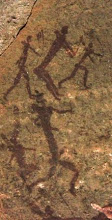Bushcraft is not only about survival a natural environment, but also how to thrive and get maximum enjoyment and pleasure out of the great outdoors, while in the process, showing utmost respect and care towards Mother Nature. Bushcraft involves learning ancient skills such as fire making, hunting, tracking, the use of tools, shelter building and protecting yourself from dangerous wildlife.
In the posts that follow I will discuss some fascinating bushcraft techniques which you can practice at home or in the outdoors.
Finding Honey
The Bushmen were so serious about their honey that honey theft was punishable by death! Natural bee hives were marked and tended by generations of families, who even build protective barriers around natural hives to protect them from Honey badgers. We take sweetness for granted, but for the African people, this was their only source of concentrated sweetness and they had some ingenious ways of finding bees and bee hives.
Here are a few methods they used:
Catch a bee and tie a long strand of spider silk to one of its hind legs and release it. Ensure that the bee is carrying pollen as this means that it is on its way home. The drag created by the web slows the bee down, allowing you to follow it back to the hive and to determine if it is viable to attempt to harvest the honey. Some hives are simply impossible to utilise, too high or too deep. Untie the bee...
Another method used was to pick a branch from a Tamboti tree (Spyrostachus africana), and beat the leaves against the stem of the tree. This releases the scent from the leaves which attracts small sting less black honey bees, which produce a clear watery honey with a delicious flavour. They would then 'track' the bees back to their hive, mainly by using the wind direction. This takes patience, but in the wilderness, there is plenty of time, and honey is good motivation.
Food - Skewered Rhinoceros
This is what you will need:
20 Zulu warriors
1 Large Rhinoceros
Large chainsaw
1 Long sharp pole
1 Truckload of firewood
20L Gasoline
1 Construction crane
Fetch the rhino.
Using the chainsaw, remove the horns and keep them aside.
Remove the skin. This avoids having to scrub it down.
Insert the skewer pole.
Douse the firewood with the gasoline, stand back and ignite.
Hang skewer over fire with crane.
Leave to cook for a week.




